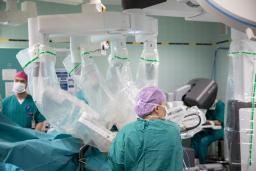Robotic surgery improves surgery results and helps patients recover faster
Keywords:HUS has performed 10,000 robot-assisted surgeries. Robotic surgery allows for less invasive surgery and faster patient recovery. It has improved surgery results and expanded surgical possibilities in several medical specialties.

The first Da Vinci robotic surgical system was introduced sixteen years ago. Since then, robotic surgery has expanded to five robots and six specialties at Meilahti, Peijas, and Jorvi hospitals, and at Women’s Hospital. Altogether, we have performed 10,000 robot-assisted surgeries.
“Robot-assisted surgeries are most commonly performed in urology, gastrointestinal surgery, gynecology, and cardiac and thoracic surgery,” says Director of HUS Abdominal Center, Mika Matikainen.
In urology, which has spearheaded robotic surgery adoption, we have performed more than 6,000 robot-assisted prostate, kidney, and bladder surgeries since 2009.
The robot has replaced open surgery in prostate removal
Robotic surgery allows for less-invasive, endoscopic surgery that shortens patients’ hospital stays and speeds up recovery. Robotic surgery has improved surgery results and expanded surgical possibilities in several medical specialties.
In the treatment of prostate cancer, robot-assisted laparoscopic prostatectomy (RALP) has replaced open surgery almost completely. Between 2009 and 2024, more than 4,300 prostate surgeries were performed at HUS due to cancer. Kidney surgery, cystectomy and other rarer procedures as well are increasingly performed using robotic surgery techniques.
At Jorvi Hospital, a robot has been used particularly for hernia surgeries. Since 2022, more than 1,200 hernia repair surgeries have been performed at Jorvi Hospital using a robot.
“The robot makes repairing large and challenging hernias safer, speeds up patient recovery and reduces the risk of the hernia recurring,” says Tom Scheinin, chief physician in gastrointestinal surgery.
Heart and Lung Center and Gynecology will soon reach the 1,000 robotic surgeries mark
Heart and Lung Center has been performing robot-assisted lung, mediastinal, and thoracic surgery since 2009. The center will have soon performed 1,000 robot-assisted surgeries. The pace is currently 100 surgeries per year. “Patients with lung or thoracic cancer have especially benefited from the possibilities offered by robotic surgery,” says Jari Räsänen, head of general thoracic surgery.
Gynecology will also reach the 1,000 robotic-assisted surgeries mark by May 2025. “With robotic surgery, we can handle, for example, difficult endometriosis surgeries and hysterectomies more efficiently and safely than before,” says Chief Physician Päivi Lehtovirta, head of gynecological surgeries.
In pediatric surgery and ear, nose, and throat surgeries optimal visibility and precision are especially important
Pediatric surgery and ear, nose, and throat diseases also make use of robotic surgery.
In pediatric surgery, robotic surgeries started in 2019. Robotic surgery is used for general pediatric surgery and pediatric urology patients.
We have performed about a hundred robotic surgeries for child patients. ”The advantages of robotic surgery for child patients are better visibility and precision in a small space, less post-operative pain and quicker recovery,” says Annika Mutanen, chief physician in general pediatric surgery.
Ear, nose, and throat diseases have performed 70 robotic surgeries since 2014.
“Most of the patients have had a malignant tumor in the base of the tongue. We have also performed surgeries on the pharynx or larynx to remove benign lesions that have caused constriction or taken up space in the area. The robot allows good visibility of the area that is to be operated on and helps to avoid open surgery from the skin on the neck or lower facial area,” says Mari Markkanen-Leppänen, specialist in ear, nose, and throat diseases.
Nurse assistants in robotic surgery
HUS has also invested in training nursing staff in robotic surgery.
“Peijas Hospital has had specially trained nurse assistants to assist in prostatectomies since 2018. This has freed up the doctors who previously assisted in the surgeries for other tasks and improved the flow of the operations. At Jorvi Hospital, two surgical nurses have completed similar training and work as nurse assistants in hernia repair surgeries,” says Registered Nurse Tiia Matikainen from the Anesthesia and Surgery Unit.
Robots help surgeons perform and feel better at work
Robotic surgery benefits not only patients but also surgeons who operate with them.
“When operating using a robot, the operating position is more ergonomic for the surgeon than in open surgeries or in endoscopic surgery without a robot. This helps avoid the neck, spine, hand joint and tendon problems that many surgeons face,” says Matikainen.
Matikainen also says that the visibility to the area to be operated on is excellent thanks to magnifying 3D camera technology. Together with the small, pivoting and precisely controlled instruments, the equipment helps surgeons to work even more precisely.